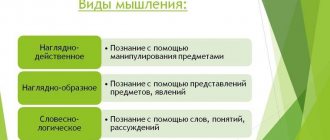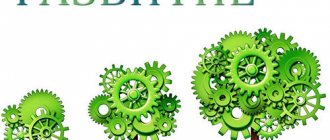All people are different, it’s hard not to notice. But they differ not only in appearance or character traits, but also in their abilities. And we all, to be honest, no, no, let’s sigh enviously - well, there are capable and talented people, and why don’t we have such talents? Abilities are one of the significant, valuable qualities, because success, fame, and material well-being are associated with them. What is this, maybe a gift from God, and someone has it, but someone is deprived? Let's figure out whether it's worth complaining and envying or whether it's better to gain these abilities and be proud of yourself.
What are abilities
We often use the word “ability” without delving into its essence. For example, the expressions “capable person” or “capable child” are not entirely correct. You cannot be capable in general; ability is always associated with a specific type of activity, in which it manifests itself and develops.
In psychology, ability is understood as a set of human qualities that provide him with the opportunity to engage in a certain activity and achieve success in it. That is, if we say that this child is capable, then we need to clarify why. You might be good at math, art, long-distance running, or surgery. There are, however, general abilities needed in different types of activities, but we will talk about them a little later.
It is safe to say that there are no incapable people, especially children. Without aptitude for mathematics, a person can achieve success in management or design, cooking or sports. And problems with spelling at school are not a reason to call a student incapable. Maybe he has the gift of a great artist?
Photographic Memory – Stephen Wiltshire
0
Source:
If you haven't seen this artist's work, you definitely should. Stephen is an autistic artist who can reproduce from memory the most detailed landscape of any city he sees from above. All it takes is a short helicopter flight over the city, and Stephen uses his photographic memory to create a panoramic image of it with stunning accuracy.
Origin of abilities and their structure
The debate about the nature of abilities lasted for hundreds of years. Some scientists believed that a person is born like a blank sheet of paper, on which you can write anything. If you choose the right method of education, then, if desired, you can raise a child into a great artist, a brilliant mathematician or an outstanding political figure.
Other scientists disagreed with them, arguing that abilities are a gift from God, and education can only get in the way. And if you don’t have an ear for music, then you will never become a great composer. And in general, you won’t become any kind of composer.
As often happens, the truth lies in the middle between these two extreme points of view.
Inclinations are the natural basis of abilities
Abilities have a complex structure. Among the qualities and properties of a person, which are united by the concept of “ability,” there are natural ones (congenital or hereditary). This natural basis of abilities is called inclinations. These include primarily psychophysiological and anatomical-physiological features.
- For example, the type of higher nervous activity or temperament - in a number of professions people with a sanguine temperament are more successful, and in others - phlegmatic or choleric people. And the sensitivity of a melancholic person can make him a great artist or poet.
- The inclinations also include innate features of the sensory system. For example, a person with a high sensitivity to color discrimination can become a good colorist, and a person with an ear for music can become a musician.
- In order to become a long-distance runner, you need a large lung capacity and endurance, and to play basketball, you need to be tall.
But the key word “can” determines the role of inclinations in a person’s life. Inclinations do not predetermine a person’s life path and may not develop into abilities, but remain “ballast”. On the other hand, the ability to perform certain activities can be developed even with weak natural prerequisites, if there is a desire. It will just take more effort and time, and not everyone needs it. For example, it has now been proven that with due persistence, anyone can learn to draw.
Inclinations are prerequisites, a kind of potential that still needs to be developed to the level of ability. And in this development, the main role is played by the social factor - the environment in which the personality is formed, the social environment, incentives and motives.
Social factor
Along with inclinations, abilities include a set of skills, abilities and knowledge related to specific activities. And only if they are present will the makings work. The formation of abilities includes a number of processes that are in one way or another related to the interaction of society and people.
- Development of potential, which is only possible through activity. That is, to become a musician, you need to learn to play at least one musical instrument. To become a writer, you must not only be able to write, but also know the laws of style, composition, etc. But most importantly, you must engage in the activity for which you want to develop abilities. They just won’t fall like manna from heaven.
- Any ability is a complex and, in addition to inclinations, includes many personal qualities. Thus, for abilities in the field of artistic creativity, the development of imaginative thinking, imagination, and intuition is important, and for success in the exact sciences, abstract logical thinking is required.
- Mastering an activity is a prerequisite for developing abilities. This involves training in techniques, methods, and techniques of activity. If a person with good abilities as a swimmer does not learn to swim, then these abilities will never manifest themselves.
Thus, abilities are the result of the development of all spheres of personality. Moreover, it is possible to develop abilities and transform potential inclinations into real mastery at any age. Although it is best, of course, to begin the development process in childhood, when the psyche is more flexible, and perception is lively and vivid, and any activity is mastered in a playful form.
Proper upbringing and sensitivity to the needs and interests of a child are a guarantee that he will grow up to be a capable person. And you need to pay close attention to the kids. The fact is that there is one interesting mental phenomenon that can suggest the presence of inclinations and the possibility of developing abilities for a certain type of activity. These are inclinations.
What are tendencies
We approach different types of activities differently - we categorically do not like something, we would like to do something, but there is not enough time, and we always find time for some activities even at the expense of our own rest or household chores.
- There are types of activities that a person has a penchant for, that is, a literally irresistible desire to engage in them. He strives for this, overcoming obstacles, making a lot of effort to master the activity he likes, enjoying the process itself. Psychologists believe that aptitudes are an indicator of a person’s potential abilities for an activity he or she likes. And if there are no inclinations, and the activities do not bring pleasure, and the result is uninteresting, then most likely it will not be possible to develop abilities.
- True, along with true inclinations there are also imaginary ones. They most often appear under the influence of a feeling of envy, when a person likes the result of the work of others so much that he also wants to learn the same thing, for example, to draw, or achieve success in sports, publish his own book, etc.
Imaginary inclinations can arise as a result of imitation. In childhood, it often happens that a child goes to a sports section or art school after his friend, without experiencing any interest in the activity itself. Or girls often want to become singers, imitating their favorite actress.
It is not difficult to distinguish imaginary inclinations from true ones. Mastering the activity in this case is not enjoyable, and the very first failures lead to loss of interest.
Supernatural Memory – Daniel Tammet
0
Source:
People with phenomenal mathematical abilities and powerful memories are not uncommon. They can solve complex mathematical equations faster than a computer or reproduce in their memory an event ten years ago with an accuracy of a second. However, Daniel Tammet is the first to describe how his brain works. For Daniel, each number from 0 to 10,000 has its own image and distinctive characteristics, such as texture, shape, color and feel. For example, the number 289 looks very ugly, the number 333 is much more attractive, and the number Pi is almost perfect. Daniel has Asperger's Syndrome and his method allows him to remember numbers and events with incredible accuracy. For example, he can reproduce Pi to the 22514th decimal place, which he did as a demonstration in 2004. It took 5 hours and 9 minutes.
Types of abilities
In psychology, there are two main types of abilities: special and general.
- Special abilities are associated with specific activities. They manifest themselves in it and develop in it. If you have never picked up a pencil or brush and tried to draw anything, then you will never know if you have the ability to draw. More precisely, a predisposition to develop these abilities. Each special ability is a complex set of innate inclinations, qualities, and personality traits. While they play an important role in a given activity, they may have no significance for the development of another. For example, an ear for music will not help you learn to draw.
- General abilities matter in many areas of activity. These primarily include cognitive abilities: development of attention, memory, imagination, intelligence. Among general abilities, the volitional sphere plays a significant role - qualities such as perseverance, determination, perseverance, and independence.
A high level of development of general abilities is called giftedness. A gifted person can master different types of activities, even without pronounced inclinations, but relying on a high level of intelligence, using figurative or abstract logical thinking and showing persistence.
And talent is a combination of giftedness and a certain special ability. If, with a high level of talent, there are many special abilities for various types of activities, then the person who possesses them is called a genius.
General abilities also include those that are required not in all types of activities, but in many, for example, organizational skills, communication, pedagogical.
But creative abilities, which have been talked about a lot lately, are not a special type of ability. In fact, there are no such abilities. And that's why.
Research confirms
More rigorous evidence comes from studies using the twin method. The mental performance of identical twins and pairs of brothers and sisters were compared with each other. The correlation of indicators within identical pairs turned out to be very high; among brothers and sisters it was significantly lower.
The results of animal studies using the method of artificial selection demonstrated the possibility of accumulation of genetic predisposition to successful learning.
Levels of ability development
Abilities are the result of a complex and dynamic process of formation under the influence of a number of factors. And in their development, abilities pass through two levels or two steps.
- The first level is reproductive (reproducing). On it, abilities are manifested within the framework of reproducing activities, that is, learning techniques, techniques, or when performing tasks according to a model. After going through the learning process, a person can remain at the reproductive level of his abilities, become a professional and even a master of his craft. But he will be distinguished by standard, stereotyped activities. He will masterfully, masterfully reproduce things, music or thoughts according to a given model, drawing, project, notes, etc. And most people remain at this level in developing their abilities. And only a few go further, rise to the next level.
- The second level is creative. Those who deviate from generally accepted standards in their development find themselves there. They are not interested in performing a task according to someone else’s model, and they come up with something of their own: they change the methods of performing activities, introduce innovations in technology, create new things, discover new laws. This level of development of abilities presupposes that a person has a special type of thinking - creative, unconventional, non-standard. Creative individuals are characterized by the activity of imaginative thinking, imagination and intuition. That is, the creative level is associated not only with special, but also with general abilities.
Consequently, abilities for any activity can become creative if a person desires to develop and has creative thinking, which, by the way, can also be formed.
The sphere of abilities is the area in which each person can show his individuality, show himself as a unique, inimitable person. You should not envy those who seem more capable and gifted to you. Better look around, and you will definitely discover an area where you can apply your own abilities, an area where you will achieve success, fame, and recognition. And such an area will definitely be found, because there are no incapable people.
Rain Man
Kim Peek
The most famous savant in the modern world, Kim Peek, was born in 1951, and from the first second of his existence it became clear that the child had big problems. His head was twice as large as that of an ordinary baby, in addition, on the back of his head it was also decorated with a cranial hernia the size of a baseball. The inside was no better than the outside: Kim was completely missing such important parts of the brain as the corpus callosum and the commissures that connect the left and right hemispheres.
And the cerebellum, which is responsible for some motor functions, was smaller than usual and deformed. But everything did not go as the doctors expected. Already at the age of one and a half years, Kim memorized the books that were read to him. He went to the Salt Lake City City Library every day and knew about 9,000 works by heart. He devoured a page in 7–10 seconds, reading the right half of the spread with his right eye and the left half with his left.
Meeting The Real Rain Man - Real Stories
Kim's brain contained all the information known to mankind regarding 15 topics of interest to him, including world and American history, sports, cinema, geography, space exploration, the Bible, church history, literature and classical music. One day, for some reason, he read the state telephone directory and memorized the numbers of all its inhabitants, and remembered in detail the maps of all cities in America.
But naturally, Kim was completely hopeless in terms of independent existence. He moved through the streets only accompanied by his father, who devoted his life to his son - he fed Kim, dressed him and tied his shoelaces. Thanks to Kim, the film “Rain Man” was born, and Dustin Hoffman spent some time communicating (so to speak) with Kim in order to get used to his future Oscar-winning role.
Daniel Tammet
Daniel Tammet - easily multiplies three-digit numbers in his head, knows at least 10 foreign languages (and also created one of his own), easily extracts cube roots in his head and “feels” prime and composite numbers. At the same time, Daniel is autistic, which means that, along with his highly developed abilities, many completely simple things are inaccessible to him.
He once learned Icelandic in a week, doing it as part of a reality show, almost in front of shocked viewers. Daniel Tammet's world is all about numbers. He sees them everywhere and in everything, and behind each number he has his own image. So, some numbers are ugly for him, others are beautiful, and when he does the most complex calculations in his mind, he simply “sees” them.
Autistic savant Daniel Tammet on 'the language of numbers' - BBC Newsnight
We already know that this is called synesthesia. It often occurs in gifted people.
Jaws of Steel – Radhakrishnan Velu
0
Source:
It is impossible to imagine what kind of strength a person must have who is able to drag a train of several cars with his own teeth, as Radhakrishnan Velu, a native of Malaysia, does. For such strong teeth he is called the “Tooth King”. And it’s still unclear - how can you drag a train weighing 260.8 tons over a distance of 4.2 meters, excuse me, with your teeth? The Tooth King claims that when he was 14, an Indian guru taught him to control all parts of the body with the help of his teeth.
Stomach of Steel – Michelle Lotito
0
Source:
The Frenchman Michel Lotito (1950 – 2007) had an insatiable appetite for completely inedible objects. It is clear that with such abilities there is a direct path to becoming a pop artist. At his performances, “Monsieur Eat Everything” devoured objects made of metal, glass, rubber and plastic, and even indigestion did not torment him later. He is also known for dismantling and gradually eating (over two years) an entire airplane. The walls of Lotito's stomach were twice as thick as they should be, and his gastric juices also worked unusually strong and allowed him to digest everything.
Gifted children
Gifted children are found in all countries, although they are not always recognized and developed in a timely manner. Rare people reach the level called genius. Mental talent is a biologically innate quality. It may develop, or it may fade away. It takes willpower, hard work and motivation to achieve for talent to become a genius. And these qualities are not developed in people to the same extent. Family upbringing and social influence play a big role.
And it also happens that a child who was not recognized as gifted from childhood, despite this, later becomes a genius and gives great discoveries to humanity. Thus, school teachers considered Einstein and Mendeleev to be mediocre. P. Gauguin's artistic talent appeared only at the age of 38, and S.T. Aksakova - at 50. Thanks to incredible hard work, they reached creative heights. And along this path they formed as individuals.










